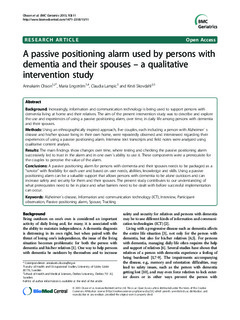| dc.contributor.author | Olsson, Annakarin | |
| dc.contributor.author | Engström, Maria | |
| dc.contributor.author | Lampic, Claudia | |
| dc.contributor.author | Skovdahl, Kirsti | |
| dc.date.accessioned | 2014-02-17T08:57:04Z | |
| dc.date.available | 2014-02-17T08:57:04Z | |
| dc.date.issued | 2013 | |
| dc.identifier.citation | Olsson, A., Engström, M., Lampic, C., & Skovdahl, K. (2013). A passive positioning alarm used by persons with dementia and their spouses – a qualitative intervention study. BMC Geriatrics, 13(11), -9. doi: 10.1186/1471-2318-13-11 | no_NO |
| dc.identifier.uri | http://hdl.handle.net/11250/142387 | |
| dc.description.abstract | Background: Increasingly, information and communication technology is being used to support persons with dementia living at home and their relatives. The aim of the present intervention study was to describe and explore the use and experiences of using a passive positioning alarm, over time, in daily life among persons with dementia and their spouses.
Methods: Using an ethnographically inspired approach, five couples, each including a person with Alzheimer´ s disease and his/her spouse living in their own home, were repeatedly observed and interviewed regarding their experiences of using a passive positioning alarm. Interview text transcripts and field notes were analyzed using qualitative content analysis.
Results: The main findings show changes over time, where testing and checking the passive positioning alarm successively led to trust in the alarm and in one own´s ability to use it. These components were a prerequisite for the couples to perceive the value of the alarm.
Conclusions: A passive positioning alarm for persons with dementia and their spouses needs to be packaged as a “service” with flexibility for each user and based on user needs, abilities, knowledge and skills. Using a passive positioning alarm can be a valuable support that allows persons with dementia to be alone outdoors and can increase safety and security for them and their spouses. The present study contributes to our understanding of what prerequisites need to be in place and what barriers need to be dealt with before successful implementation can occur. | no_NO |
| dc.language.iso | eng | |
| dc.subject | Alzheimer´s disease | no_NO |
| dc.subject | tracking | no_NO |
| dc.subject | spouse | no_NO |
| dc.subject | passive positioning alarm | no_NO |
| dc.subject | participant observation | no_NO |
| dc.title | A passive positioning alarm used by persons with dementia and their spouses – a qualitative intervention study | no_NO |
| dc.type | Journal article | no_NO |
| dc.type | Peer reviewed | |
| dc.source.pagenumber | -9 | no_NO |
| dc.source.volume | 13 | no_NO |
| dc.source.journal | BMC Geriatrics | no_NO |
| dc.source.issue | 11 | no_NO |
| dc.identifier.doi | 10.1186/1471-2318-13-11 | |
| dc.identifier.cristin | 1035830 | |
